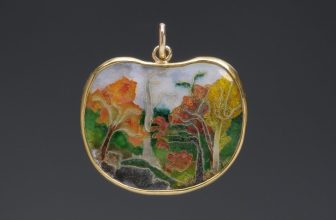
An exhibition at the Maryhill Museum of Art took us behind the wheel for a hundred-mile drive along the Columbia Gorge. “The Columbia River: Wallula to the Sea” is as ambitious in its scope as it is probing in its depth. It offers a great appreciation of both the land and its people. They may not always be in sync, but their spiritual bond is inseparable.

The last stretch of the Columbia River covers a diverse and dynamic range of ecosystems, from temperate rain forests to dry grasslands. Like its people, it has changed over the last 150 years. Landscape artists, inspired or afflicted by the scenery, document the fragile balance between man and nature with their paint brush.
While the show largely follows the geographical features down the stream, it is the “longitudinal study” of the river by generations of artists that, unexpectedly, unites the works.
The earliest paintings date to the third quarter of the 19th century. Most paintings are on loan, either from private collections or the Oregon Historical Society. With the exception of James Everett Stuart, early painters were trained on the East Coast, where the Hudson River School had flourished for decades. For them, the Pacific Northwest supplemented the quickly disappearing wilderness in the east with its untamed, primeval nature. Like their predecessors, they offered a vision where man and nature coexist peacefully.
In Raymond Dabb Yelland’s ‘Table Mountain’, a vantage point of Mt. Hood from its east side suited his luminism style – a glowing orange sky is mirrored in the Columbia River. Rapids flicker with scratching darkness. Mt. Hood looms majestic in its own purple shadowed profile.
James Everett Stuart, a student of Yelland, eventually opened a studio near The Dalles. In “The Great Chief”, the columnar rock formation near Miller Island is exaggerated to an enormous height that dwarfs the encampment below. The theatrical light on the rock against a darkened sky suggests a world of mythology and hardship against the basic elements of nature.

The earliest work is from John Mix Stanley. His lithograph of “Old Fort Walla Walla” from 1853 showed his acuteness and empathy toward the native Indians. Here he scaled back the geological features of cliff and water by compressing the space, leaving human activities at the center. Near a few teepees is a facility building from the Hudson Bay Company. It was the fur trapping business that brought commercial activities into the region. Soon, other business ensued.
By the turn of the 20th century, some artists changed both the method and their vantage point. The photography medium pushed them closer to their subject. Aided with an unwavering fidelity, these images reveal how common people like fishermen and log rafters have been shaped by the river.

Benjamin Gifford’s early photograph of Celilo Falls captured what the area around Maryhill Museum of Art looked like before the construction of the Dalles Dam in the 1950s. In one photo, Indigenous people used long spears and dipnets to catch fish. Despite the abundance of salmon, fishing by the natives was regulated to accord with the rhythms of nature. One label reads that the right to place fishing scaffolds was inherited and passed from one generation to the next. In the other photo, a man is standing as still as the rock underneath, watching the falls alive around him. Water swells upward or rushes downward with great force. There is so much foam and waves that it almost looks like a photo version of Friedrich’s iconic painting “Wanderer above the Sea of Fog.” There was power, life, and exuberance in the river, and now all of that is lost.
The exhibition features two contemporary artists – Thomas Jefferson Kitts and Erik Sandgren. They were heavily involved in the making of the exhibition. In some cases, they traveled to make en plein air work or further developed studio works for specific locations along the river.
Kitts’ painting of Two Sisters Rock follows the earlier romanticized landscape tradition, but with a high-keyed palette. While Stanley treated the rock as a distant backdrop for fledgling commercial business, Kitts renders it with fidelity. Just like how they would be perceived from visitors on foot, the height and scale of the rock look more formidable when propped from below.

In Memaloose, Kitts basks massive basalt cliffs in warm light from the golden hour. The river, tucked under the cliff over the north shore and partially blocked by the trees on the south shore, is seen as strands of turquoise. I only wish the painting would be bigger. While the columnar formation is ubiquitous along the Gorge, the climate on the east side of Hood River becomes dry enough such that the cliff can be seen in its entirety without any vegetation coverage. Thus the sighting of the cliff along I-84 is more impressive with the enormous scale than its geological features.
But much of the rest of their paintings are humanized landscapes. Over the last 100 years, a series of industries have made their marks on the river, ranging from fur trapping, logging, to commercial fishing, hydraulic manufacturing, and shipbuilding. Neither artist can leave out how the people have changed the land. In Sacred Rights, Kitts depicts a forlorn fishing platform, overlooking stagnant water in azure blue. In Nude Beach, Sauvie Island, two leisure bathers are enjoying a warm beach with cool shadows. More than 200 years ago, the island was one of the most populated areas for the Native Indians.
Erik Sandgren, whose works were already familiar thanks to the Rental Sales Gallery in Portland, supplies woodblock prints, watercolor, and acrylic paintings to the show. Most of all, he approaches his landscape through the lens of human intervention of the river, past and present. In doing so, he invites viewers to rethink what should be the future identity of the river.

In Google Server Farm, Sandgren draws our attention to an unassuming scene along the river. Tech giants like Google or Amazon have come to the area to build server farms for data centers or AI computing, mainly to take advantage of water and to leverage big tax breaks.
It takes time for both government regulation and artists to understand the impact of new technology. I am wondering how my emotional reaction would change in 20 years. Sandgren does offer an alternative – a few harbor scenes in the lower Columbia section where bustling townships, like Knappton and Cathlamet on the north shore, slip into obscurity once commercial fishing and lumber business were gone. In these quiet images, Sandgren presses two types of history together, nature’s and man’s. One is a creature of cycles while the other aims for a straight line of progress, development, and control, with mixed results. In the long game measured by time, perhaps nature wins.

The exhibition’s show-stopper is Sandgren’s four-panel visionary landscape painting with composite landmarks stretching more than 300 miles. “Wallula to the Sea”, from which the exhibition is titled, adopts an oriental practice of shifting vantage points, like revealing a Chinese handscroll. The compressed distance enables juxtaposition of majestic features unified by the river and its mist.
Sandgren is at his best when he is free from referencing specific locales. His loose and energetic brushstrokes evoke myths and legends. Here and there, the human left traces, like a bridge, a fishing scaffold, a few windmills, or a row of forlorn pilings. Such traces nevertheless become minuscule amid the cliffs, the mountains, and the great Columbia River. The water rushes forward. That essential nature comes alive like a spiritual force, unbounded and unstoppable.
Discover more from Urban Art & Antiques
Subscribe to get the latest posts sent to your email.







